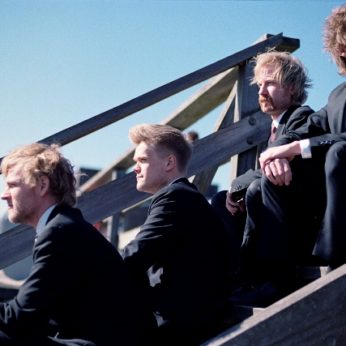Composer: Wolfgang Amadeus Mozart (b. 1756 - d. 1791)
Performance date: 27/06/2010
Venue: St. Brendan’s Church
Composition Year: 1783
Duration: 00:27:25
Recording Engineer: Anton Timoney, RTÉ lyric fm
Instrumentation: 2vn, va, vc
Instrumentation Category:String Quartet
Artists:
Danish Quartet (Frederik Øland, Rune Sorensen [violins], Asbjørn Nørgaard [viola], Fredrik Sjölin [cello]) -
[quartet]

This dark-coloured, multi-faceted
quartet is the second of the six quartets that Mozart dedicated to
Haydn, famously describing them as his children and the fruit of
long and laborious efforts. Mozart had never said this about any
of his other works. We cannot hear the effort involved but the
intensity and concentration of the process of composition can be seen
on the manuscript scores, nowhere else does Mozart make so many
corrections, strewn above crossed-out tempi and dynamic markings.
These quartets that Mozart worked on so
hard over a three year period were his response to Haydn’s recent
publication of his so-called Russian Quartets (Op.33). The
development of the string quartet was still in its infancy – Haydn’s
first quartets date from the late 1750s – so the two friends were
making up the rules as they went along, with Mozart building on the
foundations laid by the older composer. Both of them followed the
convention of the time by publishing their quartets in sets of six,
but their individual situations were very different. Haydn was
employed as Kapellmeister by Prince Esterházy in charge of a
hand-picked orchestra, whose leading string players made up a quartet
so he did not have to struggle to sell his works. Mozart, however,
was a freelance composer and was dependent on commissions and on
selling his music to publishers. He also had to be both a promoter
and performer of his own works, most notably the piano concertos. The
quartets he dedicated to Haydn were not commissions and were almost
certainly composed for his own artistic fulfilment and to gain the
respect of Haydn, but economic necessity may have played a part in
dragging out the composition process. This was a time when quartets
were almost entirely for domestic performance by amateur players.
Mozart would regularly host chamber music evenings at his house and
his friends, including Haydn and other Viennese composers like
Dittersdorf, would join him to play their quartets – Haydn would play
first fiddle and Mozart the viola, an event a musical time-traveller
would dearly like to witness.
The D minor quartet is the second in
the sequence and Constanze used to say that Mozart wrote it while she
was in labour with their first child. She even claimed her cries were
scored in the great outburst in the second movement. There used to be
a romantic school of thought that considered all Mozart’s D minor
works spoke of darkness and tragedy and that the tragic demeanour of
the music reflected some terrible event in the composer’s life, which
is hardly the case with this work. Much more likely an explanation
for the presence of the minor key was the convention that one work in
a set of six should be in the appropriate minor key and Mozart
undoubtedly seized the opportunity to show how he could make a
quartet sound as tragic as one of his operatic heroines.
We all know that Mozart had a difficult
life. He was the first composer to try to make a living without a
proper salaried post. This was long before copyright existed so there
was no question of royalties, so he could see his operas being
produced all over Europe and not make a penny from them. On top of
that he was a free spender when the money was flowing, so he had to
keep working almost without a break. This took a serious toll on his
health and like Schubert and Mendelssohn he worked himself into an
early grave. So there is little doubt that Mozart’s own experience of
life’s vicissitudes added emotional depth to his evocation of the
dark world of the minor key.
Copyright © 2024 West Cork Music. All rights reserved.
Designed and developed by Matrix Internet